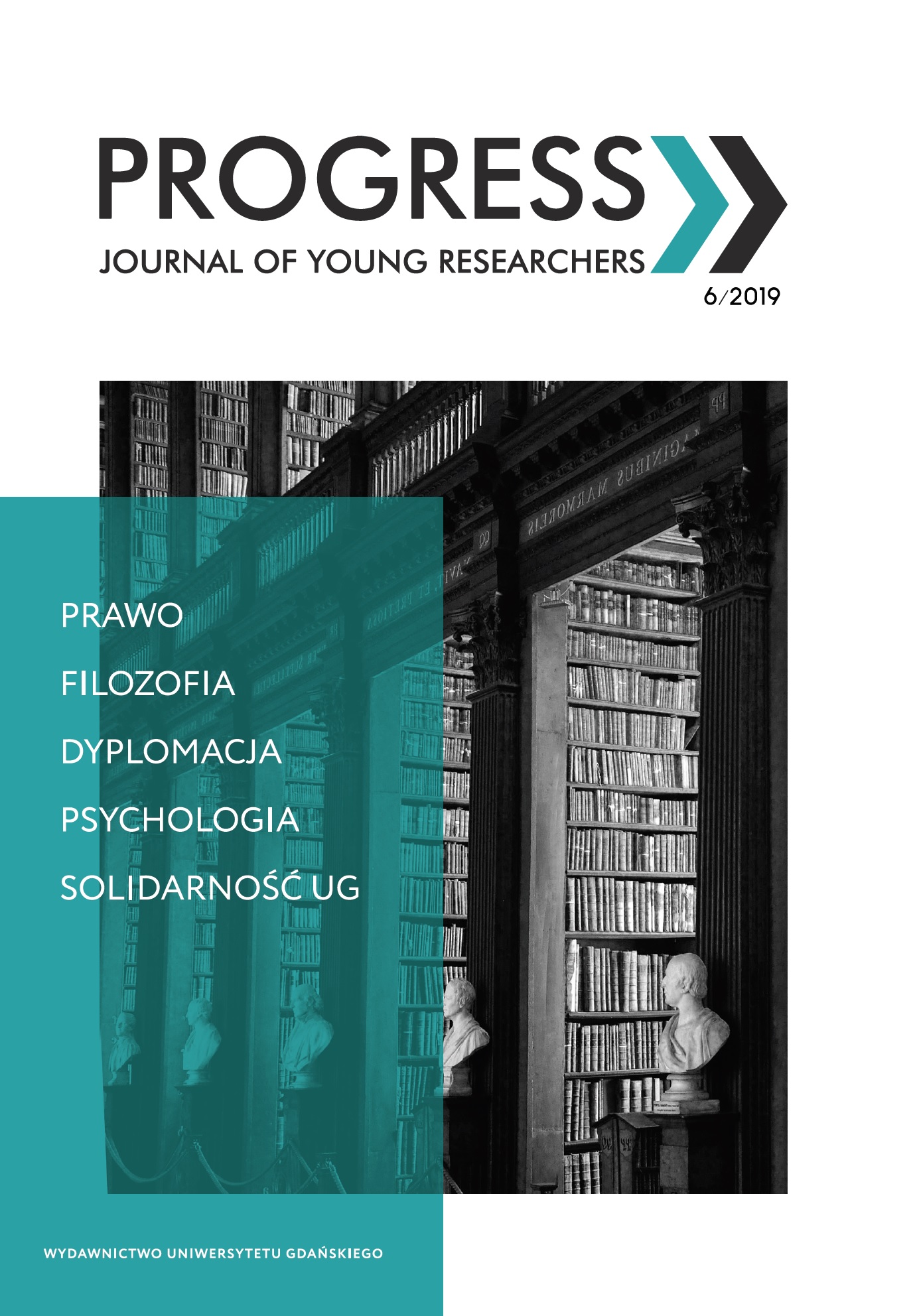Type of temperament and level of emotional self-control of juvenile offenders
DOI:
https://doi.org/10.26881/prog.2019.6.04Keywords:
temperament, emotional selfcontrol, juvenile offendersAbstract
The aim of the study is to find out the relationship between temperament type and level of emotional self-control in juvenile offenders. The following research tools were used in the study: F. Littauer’s temperament questionnaire, Buss and Plomin’s temperament questionnaire (EAS-D) and Jerzy Brzezinski’s emotional self-control questionnaire (KKE). The study was conducted on a group of men (N = 36) aged 18–21, serving a prison sentence in penitentiary units at the District Inspectorate of the Prison Service in Gdańsk.
The results showed that juvenile prisoners are characterized by a mixed temperament. In addition, they tend to react with negative emotions – dissatisfaction and fear. In addition, they show emotional motivation and a low level of control over the situation. The respondents showed high emotional excitability. The conducted analyzes contribute to increasing knowledge about the functioning of juvenile offenders. They can also be used for minors. The results can be used to create more individual rehabilitation programs and psychological help.
Downloads
References
Allnutt S., Wedgwood L., Wilhelm K., Butler T., 2008, Temperament, substance use and psychopathology in a prisoner population: implications for treatment, „Australian and New Zealand Journal of Psychiatry”, Vol. 42, No. 11.
Allport G.W., 1937, Personality: A psychological interpretation, New York.
Baumaister R.F., 2000, Utrata kontroli, Warszawa.
Brzeziński J., 1974, Kwestionariusz kontroli emocjonalnej (nieopublikowany skrypt).
Cale E.M., 2006, A quantitative review of the relations between the “Big 3” higher order personality dimensions and antisocial behavior, „Journal of Research in Personality”, Vol. 40, No. 3.
Center D.B., Jackson N., Kemp D., 2005, A test of Eysenck’s antisocial behavior hypothesis employing 11–15-year-old students dichotomous for PEN and L., „Personality and Individual Differences”, Vol. 38, No. 2.
Corr P.J., 2002, JA Gray’s reinforcement sensitivity theory: Tests of the joint subsystems hypothesis of anxiety and impulsivity, „Personality and Individual Differences”, Vol. 33, No. 4.
DeLisi M., Vaughn M.G., 2014, Foundation for a temperament-based theory of antisocial behavior and criminal justice system involvement, “Journal of Criminal Justice”, Vol. 42, No. 1.
Doliński D., 2011, Dynamika emocji, teoria i praktyka, Warszawa.
Drwal R.Ł., 1981, Osobowość wychowanków zakładów poprawczych: badania nad funkcjami podkultury zakładowej, Wrocław.
Dyakov S., Shabliy, I., 2016, The relationship of the temperament of the subject of crime with the characteristics of offences, “Psihologiâ i Pravo”, Vol. 5, No. 4.
Ekman P., 2012, Emocje ujawnione, Gliwice.
Fedeli M., 2003, Temperamenty, charaktery, osobowości: profil medyczny i psychologiczny. Kraków.
Feldman M.P., 1977, Criminal behaviour: A psychological analysis, London.
Gasiul H., 2007, Teorie emocji i motywacji, Warszawa.
Gawda B., 2010, Syntax of emotional narratives of persons diagnosed with antisocial personality, „Journal of Psycholinguistic Research”, Vol. 39, No. 4.
Gliszczyńska X., 1983, Poczucie sprawstwa [w:] X. Gliszczyńska (red.), Człowiek jako podmiot życia społecznego .
Gray J.A., 1976, The behavioural inhibition system: A possible substrate for anxiety [w:] M.P. Feldman,
A.M. Broadhurst (eds.), Theoretical and Experimental Bases of Behaviour Modification, London.
Hay C., Widdowson, A., Young B.C., 2018, Self-control stability and change for incarcerated juvenile offenders, „Journal of Criminal Justice”, Vol. 56.
Heym N., Lawrence C., 2010, The role of Gray’s revised RST in the P–psychopathy continuum: The relationships of Psychoticism with a lack of fear and anxiety, and increased impulsivity, „Personality and Individual Differences”, Vol. 49, No. 8.
Kohlberg L., 1976, Moral stages and moralization: The cognitive-development approach. Moral development and behavior: Theory research and social issues, New York.
Law, B., Crewe B., 2016, Emotion regulation among male prisoners, „Theoretical Criminology”, Vol. 20, No. 4.
Littaue F., 1994, Osobowość plus. Logos, Warszawa.
Marszał-Wiśniewska M., Goryńska E., Strelau J., 2012, Mood change in a stressful exam situation:
The modifying role of temperament and motivational tendencies, „Personality and Individual Differences”, Vol. 52, No. 7.
Mohíno S., Kirchner T., Forns M., 2008, Personality and coping in young inmates: a cluster typology, “Psychopathology”, Vol. 41, No. 3.
Niedźwieńska A., 2008, Samoregulacja w poznaniu i działaniu. Kraków.
Oniszczenko W., 1997, Kwestionariusz temperamentu EAS Arnolda H. Bussa i Roberta Plomina. Wersja dla dorosłych i dzieci. Warszawa.
Ostrowska K., Wójcik D., 1986, Teorie kryminologiczne, Warszawa.
Pastwa-Wojciechowska B., Groth J., 2016, Psychologia sądowa a psychologia kliniczna [w:] L. Cierpiałkowska, H. Sęk (red.), Psychologia kliniczna, Warszawa.
Piaget J., 1967, Rozwój ocen moralnych dziecka, przeł. T. Kołakowska, Warszawa.
Rawlings D., 1984, „The correlation of EPQ Psychoticism with two behavioural measures of impulsivity”, Personality and Individual Differences, Vol. 5, No. 5.
Rawlings D., Dawe S., 2008, Psychoticism and impulsivity. „The Sage handbook of personality theory and assessment”, No. 1.
Rest J.R., 1989, Development in judging moral issues. Minneapolis.
Sroka I.M., Isemann S.D., Walther E., 2017, With or without them: improving self-control in juvenile offenders, „Basic and Applied Social Psychology”, Vol. 39, No. 5.
Stępka E., Basińska M. A. 2015, Temperament a zmęczenie przewlekłe u funkcjonariuszy policji, „Medycyna Pracy”, t. 66, nr 6.
Strelau J., 1974, Temperament i typ układu nerwowego, Warszawa.
Strelau J., 1985, Temperament-osobowość-działanie, Warszawa.
Strelau J., 2001, Psychologia temperamentu, Warszawa.
Susłow W., Statkiewicz M., Kowalczyk J., Boińska M., Nowak J., 2015, Cechy osobowości studentów informatyki w kontekście gotowości zawodowej, „Zeszyty Naukowe Wydziału Elektroniki i Informatyki Politechniki Koszalińskiej”.
Trempała J., 2012, Psychologia rozwoju człowieka, Warszawa.
Walters G.D., 2015, Early childhood temperament, maternal monitoring, reactive criminal thinking, and the origin (s) of low self-control, “Journal of Criminal Justice”, Vol. 43, No. 5.
Zawadzki B., 2002, Temperament – geny i środowisko. Porównania wewnątrz i między populacyjne. Sopot.
Żebrowska M., Rzeszutek M., Firląg-Burkacka E., 2014, Związek cech temperamentu EAS-D ze wsparciem społecznym oraz z satysfakcją z życia u osób zakażonych wirusem HIV, „Psychologia-Etologia-Genetyka”, nr 30.
Downloads
Published
How to Cite
Issue
Section
License
Copyright (c) 2019 Author(s)

This work is licensed under a Creative Commons Attribution 4.0 International License.

 Academic Scientific Journals
Academic Scientific Journals




